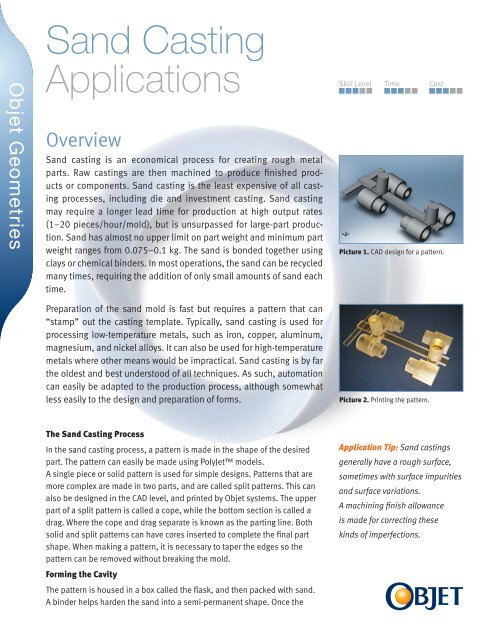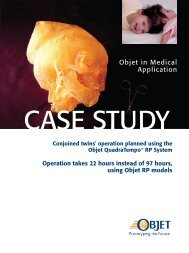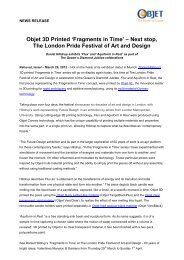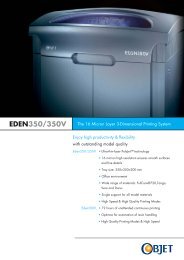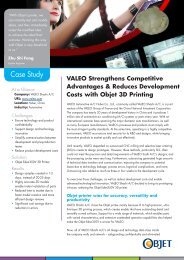Sand Casting Applications - Objet Geometries
Sand Casting Applications - Objet Geometries
Sand Casting Applications - Objet Geometries
You also want an ePaper? Increase the reach of your titles
YUMPU automatically turns print PDFs into web optimized ePapers that Google loves.
<strong>Sand</strong> <strong>Casting</strong><br />
<strong>Applications</strong><br />
Overview<br />
<strong>Sand</strong> casting is an economical process for creating rough metal<br />
parts. Raw castings are then machined to produce finished produ<br />
ucts or components. <strong>Sand</strong> casting is the least expensive of all castu<br />
ing processes, including die and investment casting. <strong>Sand</strong> casting<br />
may require a longer lead time for production at high output rates<br />
(1–20 pieces/hour/mold), but is unsurpassed for largeupart producu<br />
tion. <strong>Sand</strong> has almost no upper limit on part weight and minimum part<br />
weight ranges from 0.075–0.1 kg. The sand is bonded together using<br />
clays or chemical binders. In most operations, the sand can be recycled<br />
many times, requiring the addition of only small amounts of sand each<br />
time.<br />
Preparation of the sand mold is fast but requires a pattern that can<br />
“stamp” out the casting template. Typically, sand casting is used for<br />
processing lowutemperature metals, such as iron, copper, aluminum,<br />
magnesium, and nickel alloys. It can also be used for highutemperature<br />
metals where other means would be impractical. <strong>Sand</strong> casting is by far<br />
the oldest and best understood of all techniques. As such, automation<br />
can easily be adapted to the production process, although somewhat<br />
less easily to the design and preparation of forms.<br />
The <strong>Sand</strong> <strong>Casting</strong> Process<br />
In the sand casting process, a pattern is made in the shape of the desired<br />
part. The pattern can easily be made using PolyJet models.<br />
A single piece or solid pattern is used for simple designs. Patterns that are<br />
more complex are made in two parts, and are called split patterns. This can<br />
also be designed in the CAD level, and printed by <strong>Objet</strong> systems. The upper<br />
part of a split pattern is called a cope, while the bottom section is called a<br />
drag. Where the cope and drag separate is known as the parting line. Both<br />
solid and split patterns can have cores inserted to complete the final part<br />
shape. When making a pattern, it is necessary to taper the edges so the<br />
pattern can be removed without breaking the mold.<br />
Forming the Cavity<br />
The pattern is housed in a box called the flask, and then packed with sand.<br />
A binder helps harden the sand into a semiupermanent shape. Once the<br />
Skill Level Time Cost<br />
Picture 1. CAD design for a pattern.<br />
Picture 2. Printing the pattern.<br />
Application Tip: <strong>Sand</strong> castings<br />
generally have a rough surface,<br />
sometimes with surface impurities<br />
and surface variations.<br />
A machining finish allowance<br />
is made for correcting these<br />
kinds of imperfections.
sand mold is cured, the pattern is removed. This leaves a hollow space in the<br />
sand in the shape of the desired part. The pattern is made larger than the cast to<br />
allow for shrinkage during cooling. <strong>Sand</strong> cores can then be inserted in the mold<br />
to create holes and improve the casting’s overall shape. Simple patterns are<br />
usually open on top, allowing molten metal to be poured into them. Twoupiece<br />
molds are clamped together. Molten metal is poured into a pouring cup from<br />
where it travels down a sprue and into the gating system. Vent holes are created<br />
to allow hot gases to escape during the pour. Ideally, the pouring temperature<br />
of the molten metal should be a few hundred degrees higher than the melting<br />
point, assuring good fluidity. The temperature difference also prevents premature<br />
cooling and the resulting voids and porosity. After the metal cools, the sand mold<br />
is removed and the metal part is ready for additional operations, such as cutoff<br />
and grinding.<br />
Sprues and Runners<br />
The molten material is poured into the pouring cup, which is part of the gating<br />
system that supplies the molten material to the mold cavity. The vertical part of<br />
the gating system that is connected connected to the pouring cup is the sprue,<br />
and the horizontal portions are called the runners. The multiple points where the<br />
material is introduced to the mold cavity are called the gates. Additionally there<br />
are extensions to the gating system, called vents, that provide the path for the<br />
builtuup gases and the displaced air to vent to the atmosphere.<br />
The cavity is usually made oversized to allow for metal contraction as it cools<br />
down to room temperature. This is achieved by making the pattern oversized. To<br />
allow for shrinking, the pattern must be oversized according to certain averaged<br />
factors. There are linear factors that apply in each direction. These shrinkage<br />
allowances are only approximate because the exact allowance is determined by<br />
the shape and size of the casting. In addition, different parts of the casting might<br />
require a different shrinkage allowance.<br />
Disclaimer<br />
<strong>Objet</strong> <strong>Geometries</strong> Ltd. is not responsible for misuse of our products or their use<br />
in conjunction with unsafe or improperly maintained equipment or for uses other<br />
than intended as specified in this application note.<br />
Reference: Erie Bronze & Aluminum Company. www.eriebronze.com<br />
<strong>Objet</strong> <strong>Geometries</strong> Ltd.<br />
Headquarters<br />
2 Holzman St., Science<br />
Park<br />
P.O.Box 2496,<br />
Rehovot 76124, Israel<br />
Tel: +972u8u931u4314<br />
Fax: +972u8u931u4315<br />
<strong>Objet</strong> <strong>Geometries</strong> Ltd.<br />
Europe<br />
Leuvensesteenweg 388<br />
1932 SintuStevensu<br />
Woluwe<br />
Belgium<br />
Tel: +32u2u717u6502<br />
Fax: +32u2u717u6500<br />
<strong>Objet</strong> <strong>Geometries</strong> Inc.<br />
North America<br />
5 Fortune Drive<br />
Billerica,<br />
MA 01821<br />
USA<br />
Tel: 1u877u489u9449<br />
Fax: 1u866u676u1533<br />
www.2objet.com info@2objet.com<br />
<strong>Objet</strong> <strong>Geometries</strong><br />
AP Limited<br />
13 Floor, Unit 52A,<br />
HITEC,<br />
1 Trademart Drive<br />
Kowloon Bay<br />
Hong Kong<br />
Tel: +852u2174u0111<br />
Fax: +852u2174u0555<br />
Picture 3. The sand casting mold<br />
– forming the cavity.<br />
Picture 4. The pattern is removed<br />
from the flask.<br />
Picture 5. The desired bronze cast model.<br />
©2007 <strong>Objet</strong> <strong>Geometries</strong>, Ltd. <strong>Objet</strong>, <strong>Objet</strong> <strong>Geometries</strong>,<br />
PolyJet, Eden250 ,Eden260, Eden330, Eden350,<br />
Eden350V, Eden500V, Eden, SHR, PolyLog,<br />
QuadraTempo, <strong>Objet</strong> Quadra, FullCure® and <strong>Objet</strong> Studio<br />
are trademarks of <strong>Objet</strong> <strong>Geometries</strong> Ltd. and may be registered<br />
in certain jurisdictions. All other trademarks belong to their<br />
respective owners.


